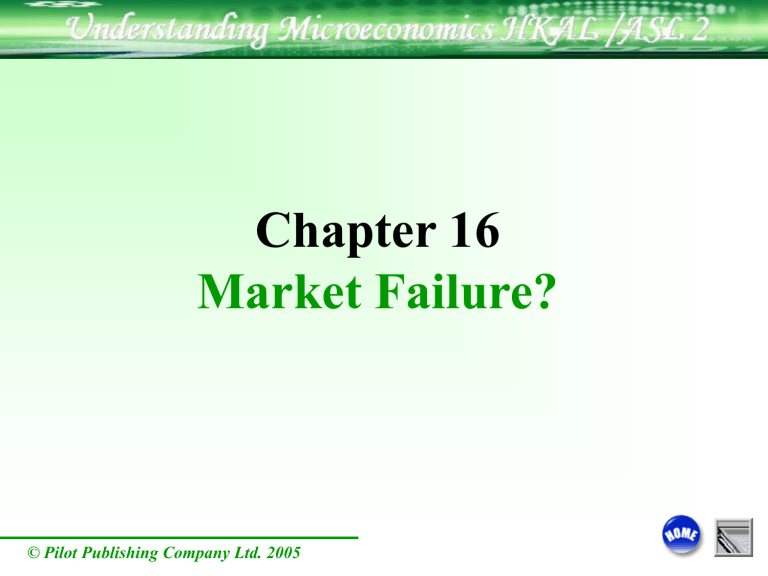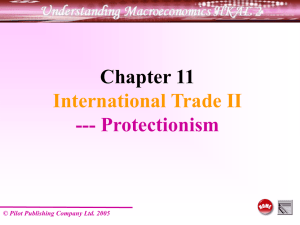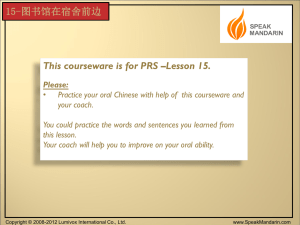Ch 16 Market failure

Chapter 16
Market Failure?
© Pilot Publishing Company Ltd. 2005
Contents:
•
Counter Argument – the Market Works!
Government Intervention is Unnecessary and Inappropriate
© Pilot Publishing Company Ltd. 2005
Examples of Market Failure
© Pilot Publishing Company Ltd. 2005
Definitions:
Market failure
is the situation in which the invisible hand (the market price) fails to allocate resources efficiently.
Externality
is the situation in which one’s action affects others
(in a non-pecuniary way) without compensation.
© Pilot Publishing Company Ltd. 2005
External cost
Private cost
is the cost borne by the decision maker.
External cost
is the uncompensated cost borne by others.
Social cost
is the total cost borne by the whole society
= private cost + external cost.
© Pilot Publishing Company Ltd. 2005
Divergence between private and social costs
is the situation in which the private cost is different from the social cost due to the presence of external cost
Example:
Noise from a construction site
© Pilot Publishing Company Ltd. 2005
Equilibrium & efficiency:
S
Deadweight loss
MSC
Private optimum :
Q p
(MPB = MPC)
MEC
MPC
MPB =
MSB
Social optimum :
Q s
(MSB = MSC)
0
Q s
Q p
Over-production
© Pilot Publishing Company Ltd. 2005
Q
External benefit
Private benefit
is the benefit obtained by the decision maker.
External benefit
is the uncompensated benefit obtained by others.
Social benefit
is the total benefit obtained by the whole society
= private benefit + external benefit.
© Pilot Publishing Company Ltd. 2005
Divergence between private & social benefits
private benefit
social benefit
due to the existence of external benefit
Example:
Fundamental education
© Pilot Publishing Company Ltd. 2005
Equilibrium & efficiency:
S
Deadweight loss
MPC =
MSC
Private optimum :
Q p
(MPB = MPC)
MEB
0
Q p
Q s
Under-production
© Pilot Publishing Company Ltd. 2005
MSB
MPB
Q
Social optimum :
Q s
(MSB = MSC)
Effects of externality
Result
(by invisible hand)
Remedy
(by visible hand)
External cost
(e.g., congestion & pollution)
Over-production
(Qp > Qs)
Impose unit tax
(to internalize the external cost)
External benefit
(e.g., public goods
& make-up)
© Pilot Publishing Company Ltd. 2005
Under-production
(Qp < Qs)
Impose unit subsidy
(to internalize the external benefit)
Definitions:
Private good
is a good of which its consumption by any individual reduces the amount available for others
it is exclusive in consumption
© Pilot Publishing Company Ltd. 2005
(Pure) Public good
its consumption by any individual does not reduces the amount available for others
it is non-exclusive in consumption
Example: Pure public good :
National defense
© Pilot Publishing Company Ltd. 2005
Impure public good
can be consumed by many but not all individuals at the same time
not all individuals can consume it (or the whole amount of it) because usually an additional cost is involved in its consumption
Examples: Impure public good
Radio broadcast
Stage performance
© Pilot Publishing Company Ltd. 2005
Q16.3:
Explain why the above are examples of pure public goods & impure public goods.
© Pilot Publishing Company Ltd. 2005
Q16.4:
Distinguish between public goods & public services.
© Pilot Publishing Company Ltd. 2005
Q16.5:
Some economists define public good as a good of which the marginal cost of serving an additional consumer is zero. Comment.
© Pilot Publishing Company Ltd. 2005
$
Demand for a public good
MUV
1
+MUV
2
= MSB
Public good is non-exclusive in consumption. Once produced, all individuals consume & pay for the same stock of public good.
MUV
2
MUV
1
Market demand curve for a public good = vertical sum of MUV curves of all individuals in the market (=
MSB curve)
0
© Pilot Publishing Company Ltd. 2005
Q
$
The social optimum
MSB =
MUV
1
+MUV
2
MUV
2
Optimal output:
MSC
MSB (=
MUV) = MSC (=MC)
Optimal pricing scheme :
Perfect price discrimination
(i.e., P i
= MUV i then
P i
=
)
MUV i
= MSC
MUV
1
P
2
P
1
0
Q s
© Pilot Publishing Company Ltd. 2005
P
1
P
2
= MSC
Q
Private optimum
If uniform pricing is practised:
1. Cannot attain allocative efficiency
To high MUV users: MUV > P
To low MUV users: MUV < P and refuse to consume
MR collected (
P) is much smaller than MSB (
MUV)
In equating MR = MC, private optimum is much smaller than social optimum
Under-production and allocative inefficiency result
2. Cannot attain consumption efficiency
Once produced, no additional cost is incurred in consumption, but low MUV users are excluded from consumption
Under-consumption and consumption inefficiency result
© Pilot Publishing Company Ltd. 2005
If perfect price discrimination is practiced:
It is extremely costly for a producer to investigate the
MUV of every individual & charge them accordingly.
Individuals may pretend to be low MUV users to bargain for a lower price.
The revenue collected from perfect price discrimination would also be smaller than MSB.
Under-production & allocative inefficiency result.
© Pilot Publishing Company Ltd. 2005
The free rider problem:
As public good is non-exclusive in consumption, it is difficult to recognize & prevent free-riders (non-payers) from consuming the good.
This free-rider problem may appear under all kinds of pricing schemes.
As a result, the revenue collected would be further reduced.
Under-production
© Pilot Publishing Company Ltd. 2005
Any remedy?
Pricing
The visible hand faces similar problems as the invisible hand.
Under-production
Zero pricing
Finance the production of public good by tax revenue
Unfair to taxpayers who bear the cost but do not consume the public good.
The sectors being taxed suffer inefficiency
When the gov’t estimate
MSB from surveys, consumers may overstate their MUVs and cause over-production
© Pilot Publishing Company Ltd. 2005
Q16.7:
“To achieve consumption efficiency, a private good should be consumed by the individual with the highest MUV, while a public good should be consumed by all individuals with positive MUVs.”
Comment.
© Pilot Publishing Company Ltd. 2005
Q16.8:
Radio broadcast is a public good.
What are the problems in its pricing?
What are the ways to overcome the problems so that it can be provided privately?
Is the situation efficient?
© Pilot Publishing Company Ltd. 2005
Counter Argument
--- the Market Works
© Pilot Publishing Company Ltd. 2005
Zero transaction cost – Coase theorem
Coase theorem ( 高斯理論 )
regardless of the initial assignment of property rights
the market equilibrium is identical and efficient
provided that property rights are well-defined and transaction costs are negligible.
© Pilot Publishing Company Ltd. 2005
Illustration of the theorem
A factory in upstream
Mr. B
Ms. A
© Pilot Publishing Company Ltd. 2005
A farm in downstream
Initial situation:
The bleaching factory discharges sewage into the river.
The sewage pollutes the river and brings loss to the farm.
© Pilot Publishing Company Ltd. 2005
Case I: The farm does not have the right of enjoying clean water.
Assumptions:
1. No law restricting water pollution (pollution continues)
2. To min. loss, farm owner Mr. B negotiates with Ms. A and pay her to cut her output and pollution.
Max. amount that Mr. B is willing to offer to Ms. A is the marginal external cost he borne = MSC - MPC
Min. amount that Ms. A is willing to accept is her net receipt from producing that unit = MPB MPC
= MSB - MPC
© Pilot Publishing Company Ltd. 2005
In equilibrium,
( Max. amount offered by
Mr. B = External cost)
=
MSC - MPC
( Min. amount accepted by
Ms. A = Net receipt)
MSB - MPC
MSC = MSB
© Pilot Publishing Company Ltd. 2005
Case II: The farm has the right of enjoying clean water
Assumptions:
1. A law restricting water pollution (& prod. is banned)
2. To min. loss, factory owner Ms. A negotiates with
Mr. B and pay him to allow her production & pollution.
Max. amount that Ms. A is willing to offer to Mr. B is the her net receipt from production = MPB - MPC
= MSB - MPC
Min. amount that Mr. B is willing to accept is the external cost he borne = MSC - MPC
© Pilot Publishing Company Ltd. 2005
In equilibrium,
( Max. amount offered by Ms. A = Net receipt)
=
MSB - MPC
( Min. amount accepted by Mr. B = External cost)
MSC - MPC
MSB = MSC
© Pilot Publishing Company Ltd. 2005
Conclusion
If transaction cost is zero, by Coase theorem, private contracting would occur. As a result, the private optimum is the social optimum .
Efficiency is achieved.
N o deadweight loss.
Notice that the initial assignment of property rights has no influence on the allocation of resources.
© Pilot Publishing Company Ltd. 2005
Remarks: 1. Optimal level of pollution
If pollution cannot be avoided in production,
(because the cost of preventing or eliminating pollution is extremely high)
it is efficient to allow pollution provided that the MSB of production can cover the MSC
(including the loss brought by pollution).
So there exists an optimal level of pollution.
© Pilot Publishing Company Ltd. 2005
Remarks: 2. Reciprocal nature of the problem
There exists no reason why someone should have the right of a resource (e.g., clean water) instead of others.
Yet, whoever has the right will gain and whoever has to buy the right will lose.
Which party bears the loss is reciprocal , depending on the assignment of rights.
© Pilot Publishing Company Ltd. 2005
Prohibitively high transaction cost
Achieving efficiency without reallocating resources
If TC in reallocating resources to restore efficiency & eliminate the deadweight loss > the deadweight loss itself,
no private contracting or reallocation of resources is worth taking place.
Although the private optimum is different from the ideal social optimum (under zero TC) & deadweight loss results, the resource allocation is still efficient (cannot be improved).
No market failure results & no government intervention is needed.
© Pilot Publishing Company Ltd. 2005
Assignment of property rights affects the allocation of resources (when TC is prohibitively high)
$
Deadweight loss
0
Q
S
Q
P1
© Pilot Publishing Company Ltd. 2005
MSC
If the farm does not have the right and the
TC is prohibitively high,
MPC
MPB=MSB
Q of factory
the factory will produced at Q
P1
$
Deadweight loss
MSC
If the farm has the right and the TC is prohibitively high,
0=Q
P2
Q
S
© Pilot Publishing Company Ltd. 2005
MPC
the factory will be banned from production, i.e., Q
P2
= 0
MPB=MSB
Q of factory
Government Intervention is
Unnecessary and Inappropriate
© Pilot Publishing Company Ltd. 2005
Gov’t intervention is unnecessary and inappropriate
As resource allocation by the invisible hand must be efficient, there is no market failure.
No government intervention is needed
The use of visible hand may be of undesirable motive, involve high administrative and information cost, and restrict individual freedom.
So even if there were “market failure”, the use of visible hand might not be appropriate .
© Pilot Publishing Company Ltd. 2005
Correcting Misconceptions:
1. Public good is a good produced by the government.
2. The market demand curve for a public good is the horizontal sum of MUV curves of all individuals in the market.
3. To achieve efficiency, private goods should be provided by the private sector and public goods should be provided by the public sector.
© Pilot Publishing Company Ltd. 2005
Correcting Misconceptions:
4. To achieve efficiency, pollution should be eliminated.
5. The existence of deadweight loss implies inefficiency.
6. Pareto efficiency requires zero transaction costs.
7. Pareto efficiency requires an even distribution of wealth.
© Pilot Publishing Company Ltd. 2005
Correcting Misconceptions:
8. Pareto efficiency implies the maximization of social welfare.
9. To achieve efficiency, a polluting firm should be banned from production or it should compensate the victims.
10. There is no divergence between private and social costs.
11. As the market fails to allocate resources efficiently, the government should intervene.
© Pilot Publishing Company Ltd. 2005
Survival Kit in Exam
Question16.1:
“A price-searching market allocates resources inefficiently.” Comment.
© Pilot Publishing Company Ltd. 2005
Survival Kit in Exam
Question16.2:
The construction of a rubbish collection point causes a fall in the value of nearby properties.
To attain economic efficiency, which of the following options should be adopted?
(a) The rubbish collection point should compensate the nearby property owners.
(b) The rubbish collection point should install pollution reduction device.
(c) The rubbish collection point should be relocated.
(d) The nearby properties should be relocated.
© Pilot Publishing Company Ltd. 2005









